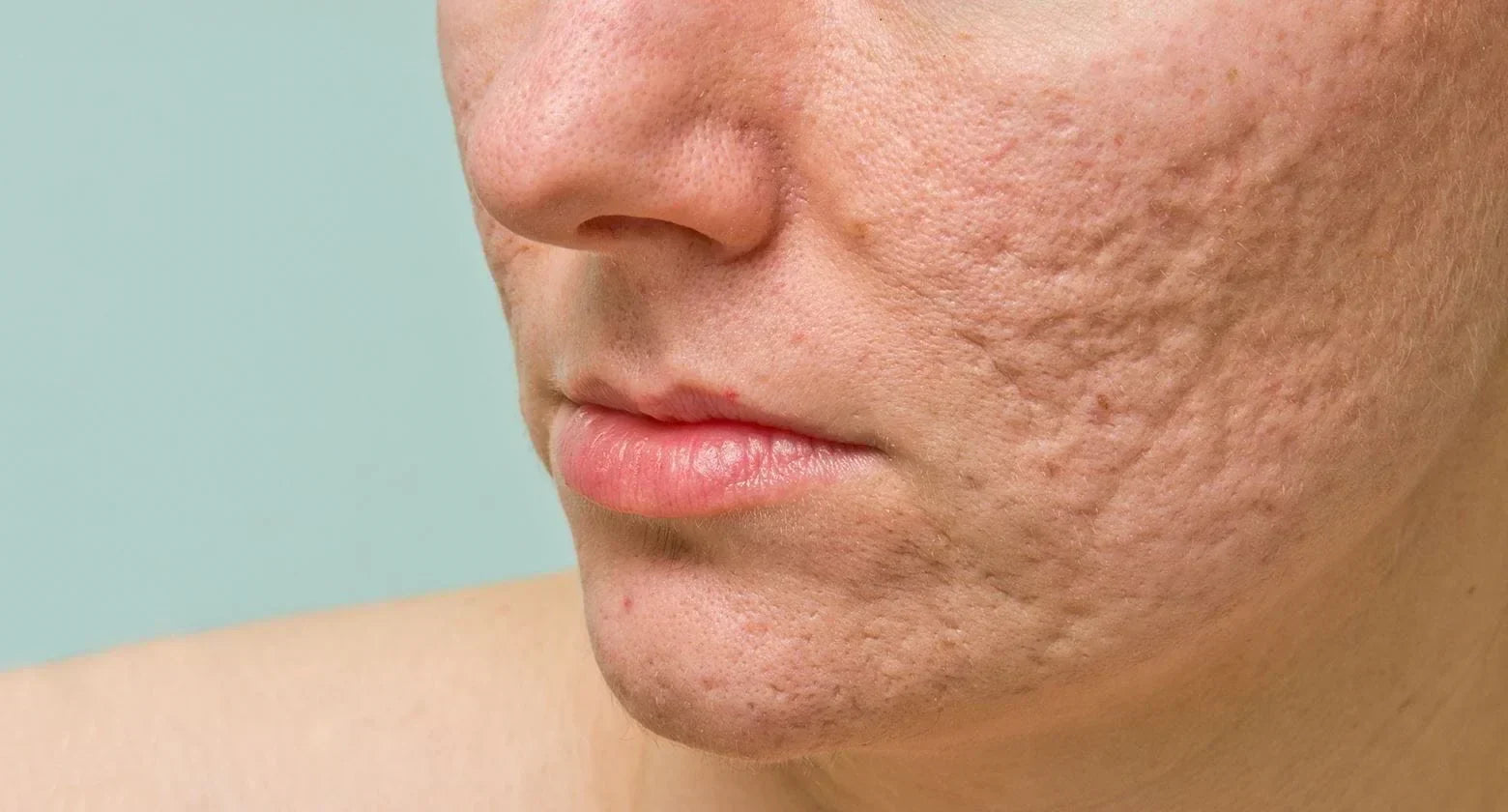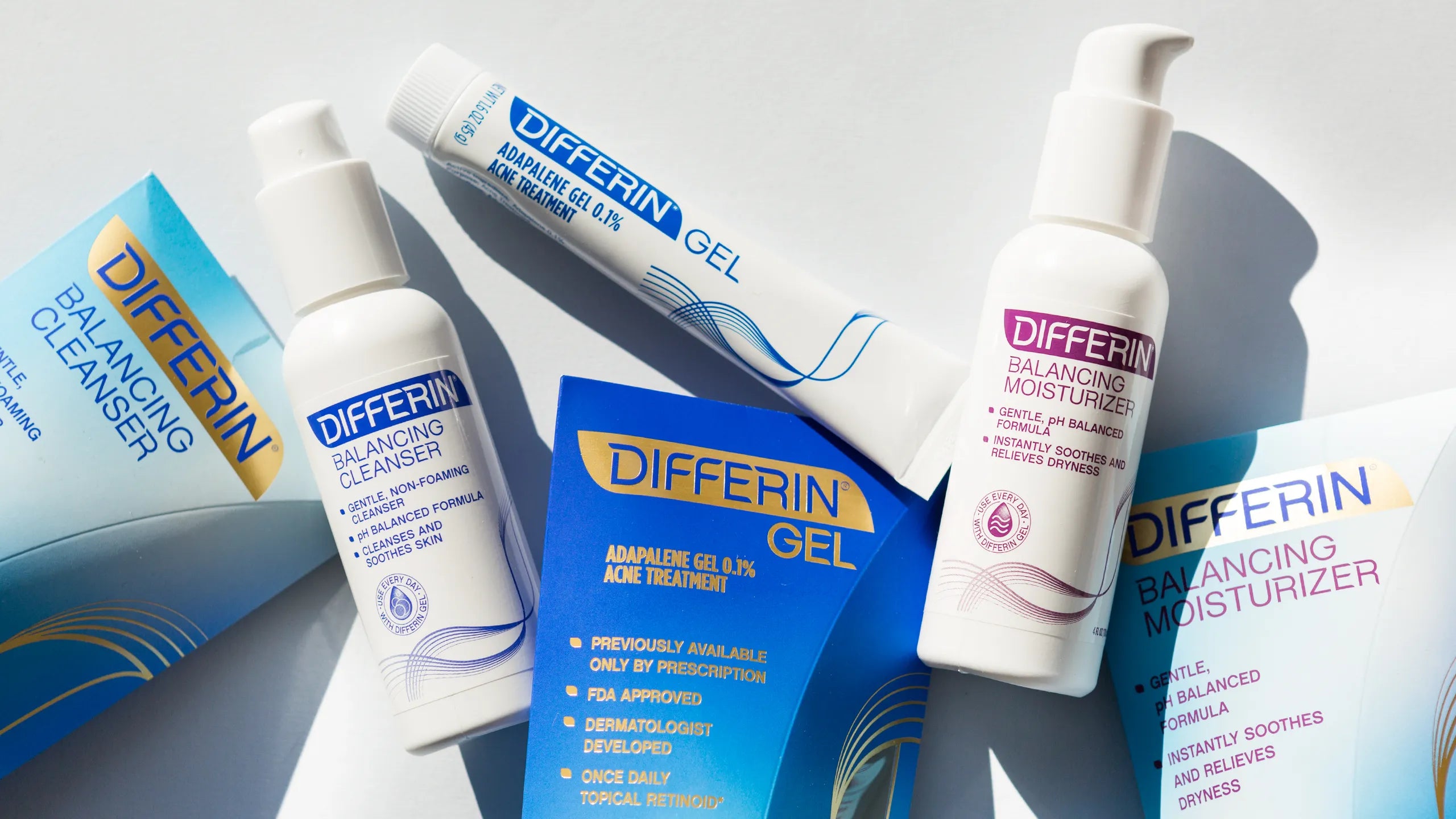Article: What Is Atrophic Scarring? Causes, Treatments, and Prevention

What Is Atrophic Scarring? Causes, Treatments, and Prevention
If you’ve ever cleared up a breakout only to notice tiny dents or uneven texture left behind, you’re not imagining it — that’s something called atrophic scarring. These scars happen when your skin doesn’t produce enough collagen during the healing process, leaving little dips or indents where acne once was.
They can be frustrating (especially under certain lighting), but the good news is that there are ways to improve their appearance and help your skin look smoother over time. Let’s break down what atrophic scarring is, why it happens, and how to treat it safely.
What Is Atrophic Scarring?
Atrophic scarring refers to depressed or sunken scars that form when your skin can’t fully repair itself after inflammation — like cystic acne, chickenpox, or even injury. When collagen production slows down during healing, the tissue underneath collapses slightly, creating an uneven surface.
In skincare terms: the inflammation from a deep breakout eats away at your skin’s structure faster than your body can rebuild it. The result? That lingering “textured” look that doesn’t go away, even after the acne is gone.
The Different Types of Atrophic Scars

There are a few kinds of atrophic scars, and identifying which one you have helps you choose the right treatment approach:
-
Ice Pick Scars: Small but deep holes that look like tiny pin pricks. They’re the hardest to treat at home because they extend deep into the skin.
-
Boxcar Scars: Wider, shallow indents with sharp edges — these often appear on the cheeks or temples.
-
Rolling Scars: Wavy, uneven texture that gives the skin a rippled appearance. These are caused by fibrous bands pulling the skin down from below.
Most people have a mix of all three, especially after years of breakouts.
What Causes Atrophic Scarring?
The main cause is inflammation — especially from severe or cystic acne. But here’s what can make scarring more likely:
-
Popping or picking pimples (you already know this one).
-
Untreated deep acne that lingers too long under the skin.
-
Overusing harsh actives that damage the barrier and slow healing.
-
Genetics — some skin types just produce less collagen naturally.
Unfortunately atrophic scarring can happen even if you just leave your acne alone! This. why it's essential to keep your acne under control before they scar, because atrophic scarring is expensive and time consuming to treat. So, the goal is to keep inflammation down, avoid aggressive products, and support your skin barrier while it repairs itself.
How to Treat Atrophic Scars
Let’s be real — atrophic scars take time and consistency to fade. There’s no overnight fix, but you can make major improvements with the right approach. Unfortunately as someone who personally has atrophic scarring from acne, the most effective way to treat these are through in-office treatments. Things like retinoids (retinol, tretinoin) help speed up skin cell turnover and overall smoothes texture but will not make much of a difference with deeper, atrophic scarring.
Professional Treatments for Atrophic Scarring: What Actually Works
When it comes to atrophic acne scars, skincare alone can only go so far. Topicals like retinoids and acids help smooth texture over time, but true indentation repair often requires stimulating collagen beneath the surface. That’s where professional dermatology or aesthetic treatments come in.
Below is a breakdown of the most common (and effective) in-office procedures for atrophic scarring — what they do, how they work, recovery times, and what to expect.
1. Subcision: Releasing the Scar from Beneath

Subcision is one of the most effective treatments for rolling or tethered scars, where fibrous bands under the skin pull the surface downward and create a wave-like texture.
How it works:
A dermatologist uses a special needle (blunt cannula) to gently insert under the scar and “break” the fibrous bands that are tethering it down. This releases tension and allows the skin to lift and even out. The procedure also causes controlled micro-trauma, triggering new collagen and elastin production as the skin heals — further improving volume and smoothness.
Best for:
-
Rolling scars
-
Some boxcar scars
Recovery:
Mild swelling or bruising for a few days. You might see early improvements right away from the release, but the true collagen remodeling happens over 2–3 months.
Pro tip: Many dermatologists combine subcision with fillers (like hyaluronic acid or Sculptra) to support the lifted area and boost collagen even more.
2. TCA CROSS: Chemical Reconstruction for Ice Pick Scars

Image courtesy of Dr. Ben Behnam
If you have ice pick scars — those narrow, deep pits that look like enlarged pores — TCA CROSS (short for Trichloroacetic Acid Chemical Reconstruction of Skin Scars) is considered one of the gold-standard treatments.
How it works:
A high-strength TCA acid (usually 70–100%) is precisely applied to each scar using a fine applicator or wooden tip. This causes a controlled chemical injury inside the scar, stimulating collagen formation from the bottom up as it heals. Over multiple sessions, the pit becomes shallower and less visible.
Best for:
-
Deep, narrow ice pick scars
-
Patients who can tolerate some downtime
Recovery:
The treated spots scab over within a day or two and usually flake off in about a week. Slight redness can last for another week or so. Most people need 3–6 sessions, spaced about a month apart, for noticeable texture improvement.
Important note: TCA CROSS should only be done by trained professionals — not at home. The high acid concentration can cause chemical burns if misused.
3. Microneedling: Gentle Collagen Induction

Microneedling, also called collagen induction therapy, uses ultra-fine needles to create thousands of micro-channels in the skin. These tiny “controlled injuries” kickstart your body’s natural healing process and encourage new collagen and elastin production.
Why it works for scars:
By stimulating remodeling deep within the dermis, microneedling can gradually smooth out shallow rolling or boxcar scars. It’s less invasive than lasers and safe for most skin tones.
Best for:
-
Mild to moderate atrophic scars
-
Rolling or boxcar scars
-
Anyone seeking subtle but cumulative results
Recovery:
Expect mild redness and sensitivity for 1–3 days (similar to a sunburn). You’ll need at least 3–6 sessions, spaced about a month apart, to see full results. Microneedling will not completely get rid of the deep atrophic scarring but will improve overall skin texture and smooth things out.
Enhancements:
-
RF Microneedling (Radiofrequency): Combines microneedling with radiofrequency energy that heats deeper layers for even stronger collagen stimulation. Great for more stubborn scars or thicker skin. Warning: definitely do your research and make sure you have a very skilled doctor/practitioner doing the treatment. If the wrong settings are used, the heat could possibly cause facial fat loss if used at a setting that is too strong so be very careful!

-
PRP “Vampire” Add-On: Using platelet-rich plasma from your own blood, applied post-needling, can speed healing and amplify results.
4. Laser Resurfacing: High-Energy Skin Remodeling
Laser treatments are some of the most powerful tools for atrophic scarring — but they vary a lot depending on your skin tone, downtime tolerance, and scar type. Some skin tones (particularly those with darker skin) may not be suitable candidates for certain lasers (mainly ablative) as it could result in hyperpigmentation. Consult with your dermatologist!
Ablative Lasers (CO₂ and Er:YAG)

These lasers vaporize the top layer of skin, forcing new collagen production and resurfacing the area for smoother texture.
-
CO₂ lasers penetrate deeper and are excellent for severe scarring but come with longer downtime (about 7–10 days).
-
Er:YAG lasers are slightly gentler, with faster healing and less risk of pigmentation changes.
Pros: Dramatic texture improvement in just 1–2 sessions.
Cons: Longer recovery, redness, and higher cost ($1,500–$3,000 per session).
Non-Ablative Fractional Lasers (Fraxel, Clear + Brilliant, etc.)

These create controlled micro-columns of heat under the skin without removing the surface layer, so downtime is minimal. They’re safer for darker skin tones and great for maintenance or milder scars.
Pros: Subtle improvements with less redness and peeling.
Cons: Multiple sessions (3–5) are needed for best results.
Pulsed-Dye or Nd:YAG Lasers
These don’t resurface but instead target redness and discoloration around scars. Often used in combination with other treatments to even tone while texture is addressed.
5. Combination Therapy: The Real Secret
Most dermatologists will tell you that no single treatment works for all scars. The most effective approach usually combines several methods tailored to your specific scar types.
Common pairings include:
-
Subcision + Microneedling/RF → releases tethered scars then boosts collagen.
-
Subcision + TCA CROSS → releases deeper scars while chemically remodeling the rest.
-
Laser + PRP → resurfaces and speeds recovery simultaneously.
The key is patience — real results take months of gradual collagen rebuilding.
6. Managing Expectations and Healing
Atrophic scars are permanent structural changes, so “erasing” them completely isn’t realistic. The goal is visible improvement, not perfection — usually 50–80% smoother texture with the right plan.
After any procedure, consistent post-treatment care is crucial:
-
Use gentle, barrier-supportive skincare (like Smood Beauty’s Calm Me Down Cleanser and Problem Solver Moisturizer).
-
Keep skin hydrated and protected from the sun daily.
-
Avoid active ingredients (acids, retinoids) for at least a week post-procedure unless cleared by your provider.
Think of these treatments as teamwork between your dermatologist and your daily routine — your in-office sessions rebuild the foundation, and your at-home skincare protects it.
Can Atrophic Scars Be Prevented?
Absolutely — the best “treatment” is prevention.
Here’s how to minimize scarring in the first place:
-
Treat acne early to prevent deep inflammation.
-
Avoid picking or squeezing pimples (seriously).
-
Stay consistent with barrier repair and gentle exfoliation.
-
Use SPF daily, since sun exposure can make scars look darker and more visible.
Final Thoughts
Atrophic scarring takes time to treat, but with the right combination of professional treatments and barrier-nourishing skincare, you can dramatically smooth your skin’s texture and boost confidence. Whether you’re starting with microneedling or considering subcision and lasers, the most important step is choosing an experienced provider — and supporting your skin every day while it heals.
The key is patience and care. Focus on calming inflammation, rebuilding collagen slowly, and supporting your barrier with gentle, consistent products. Smooth skin takes time, but it’s completely possible with the right mix of science, consistency, and self-kindness.



Leave a comment
This site is protected by hCaptcha and the hCaptcha Privacy Policy and Terms of Service apply.